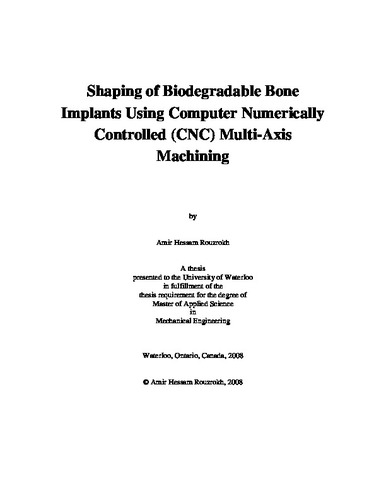| dc.contributor.author | Rouzrokh, Amir Hessam | |
| dc.date.accessioned | 2008-09-24 17:51:15 (GMT) | |
| dc.date.available | 2008-09-24 17:51:15 (GMT) | |
| dc.date.issued | 2008-09-24T17:51:15Z | |
| dc.date.submitted | 2008-09-17 | |
| dc.identifier.uri | http://hdl.handle.net/10012/4023 | |
| dc.description.abstract | This thesis presents the use of Computer Numerically Controlled (CNC) machining as a method to manufacture anatomically-shaped synthetic grafts made from Calcium Polyphosphate (CPP) ceramic. Tissue-engineered cartilage is grown on the surface of these implants in vitro followed by in vivo implantation in the host’s body for osteochondral focal defect repair. While most current implants are manufactured from simple geometries and are not specific to one patient’s need, it is believed that custom manufactured implants (from computer tomography data) representing the exact shape of the original bone will be beneficial. This is because custom implants permit an even stress distribution on the cartilage, resulting in increased cartilage survival rates. The present study has successfully manufactured and delivered a custom designed implant with sufficient surface porosity and minimal chipping. This was accomplished by effectively modeling the machinability characteristics and finding the optimal cutting conditions for CPP.
CPP’s machinability characteristics were investigated and a cutting force prediction model was developed. This model was verified by a comparison of experimental and predicted forces for a number of ball and flat endmilling tests. The optimal cutting conditions that would result in maximum surface porosity and minimal chipping were established through qualitative investigation of results from varied conditions using Scanning Electron Microscope (SEM) images. Using the established optimal cutting conditions from machinability studies, the multi-axis machining process for producing the designed custom implant was developed and all stages were simulated for accuracy and integrity of the final implant.
The designed toolpaths were tested on prototyping wax and verified against the actual Computer Aided Design (CAD) model using an optical microscope. The same toolpaths were executed on a block of CPP and the final implant was again investigated for surface porosity and chipping. After final comparison against the CAD model using an optical microscope, the implant was delivered to surgeons for implantation. | en |
| dc.language.iso | en | en |
| dc.publisher | University of Waterloo | en |
| dc.subject | CPP | en |
| dc.subject | 5-axis | en |
| dc.title | Shaping of Biodegradable Bone Implants Using Computer Numerically Controlled (CNC) Multi-Axis Machining | en |
| dc.type | Master Thesis | en |
| dc.pending | false | en |
| dc.subject.program | Mechanical Engineering | en |
| uws-etd.degree.department | Mechanical and Mechatronics Engineering | en |
| uws-etd.degree | Master of Applied Science | en |
| uws.typeOfResource | Text | en |
| uws.peerReviewStatus | Unreviewed | en |
| uws.scholarLevel | Graduate | en |

